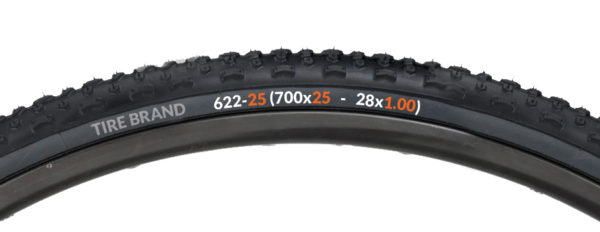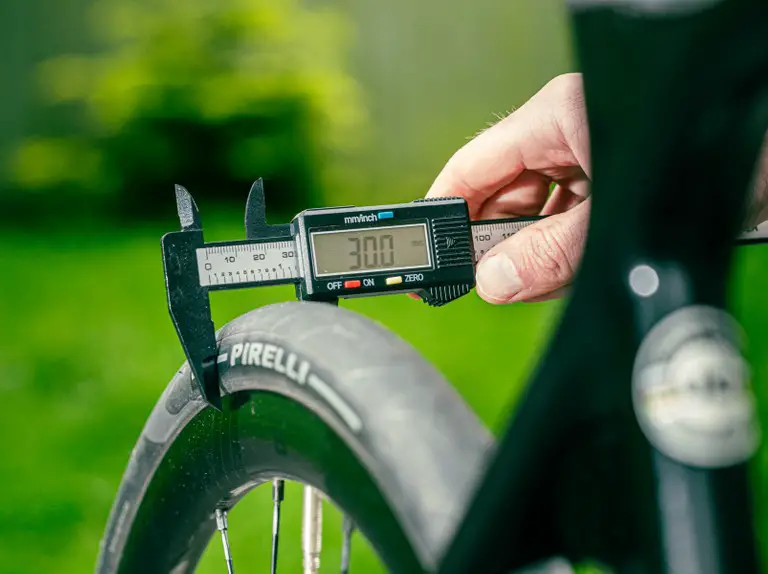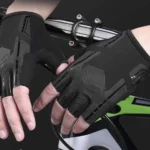
When it comes to replacing your bike tires, it can be overwhelming to find the right one. To ensure your safety and prevent damage, you need to make sure the tire fits perfectly on your rim. So what is the process for measuring a bike tire?
To simplify the process, start by checking the size of your old tire. Usually, this is all you need to find a compatible replacement. However, sometimes you may miss the numbers on the tire or struggle to understand the combination of inches and millimeters.
To avoid these problems, it’s essential to know how to measure your bike tire. The measurement includes the rim diameter and the tire width in millimeters. This will help you select the right tire size for your bike. To learn more about measuring your bike tire, keep reading.
Interpreting the Numbers

Before standardization, bike tire sizes were described differently by each manufacturer. Today, with the introduction of ISO standard notation by ETRTO, it’s easier to find the right size tire for your bike’s rim.
This system eliminates inconsistencies in sizing and makes tire measurement straightforward. In the ISO system, tire sizes are represented by numbers separated by a dash. The first two digits indicate the tire width, while the last three digits show the bead diameter, which fits the tire to the rim.
The bead diameter is the most crucial aspect of tire measurement. The ISO system offers a hassle-free way of determining tire size, especially when you have no information about your bike tires. With the standardization of bike sizes, a wide range of wheel sizes is available for different types of bikes, such as folding bikes and recumbents.
If your bike tire doesn’t have the key numbers for ISO standard notation, don’t worry! You can still measure your tire using the traditional method. Here’s what you need to do:
- Gather the tools you need for measurement.
- Measure the rim diameter.
- Measure the tire width in millimeters.
- Combine the measurements to determine the tire size.
Procedure: A Step-by-Step Guide
1. Prepare
Preparation is crucial for a successful outcome, even for a simple task like measuring your bike tire. To make sure you have everything you need, gather these essential tools:
- Bike tire lever: This tool is made of hard plastic or steel and has a curved end that can be rounded or squared. It is used to slip under the lip of the bike tire and sometimes comes with a small hook to secure leverage when deflating tires.
- Caliper: A caliper is crucial for getting an accurate width measurement of your tire. It’s a sliding ruler with jaws designed to measure diameter and thickness.
- Tape measure: You can use a tape measure to determine the tire’s width in millimeters.
With these tools on hand, you’re ready to move on to the next step of measuring your bike tire.
2. Determine the tire’s rim diameter

In this step, you want to position your bike for an accurate measurement. This means finding a good viewing angle and making sure you have a stable posture while working.
To do this, prop your bike securely against a wall or use its kickstand to prevent it from falling and causing injury while you measure the tire.
Use a tape measure to find the length in millimeters from the center of the wheel to the inner edge of the tire. Double this measurement to get the diameter. For accuracy, stretch the tape measure in a straight line to the edge of the tire.
If you want your measurements to conform to ISO standards, use a slightly different technique. Place the tape from the center of the wheel to the inner edges of the tire. Then multiply the measurement to find the tire diameter.
3. Determine the tire’s width in millimeters
In this step, you can use either a tape measure (with this tool) or a caliper to determine the width of your tire. To get the measurement, simply measure across the tread from one side to the other. Remember that when buying a new tire, the width will be listed before the diameter according to the ISO system.
You can also use a tape measure by placing it on the ground, crossing the tire’s tread in a straight and precise manner. The figures you get correspond to the width in millimeters, but if you need the traditional measurement, you can convert millimeters into inches.
Keep in mind that there is no standard width for bicycle rims. The width of rims varies and can range from 13mm to 29mm. The rim width affects the tire width, so it’s essential to measure the internal rim to determine the minimum and maximum tire size it can support.
4. Combine the numbers
To measure your bike’s tires correctly, you need to have two key figures. In conventional tire measuring, the diameter should be written before the width, but in the ISO system, the width should come first, followed by the diameter.
When combining your measurements, keep in mind that compatibility is key. Ensure that the wheel is compatible with the tire to avoid any confusion. There are rims designed for wider tires, and the tire width depends on the internal width of the rim. For example, you cannot use narrow tires on wide bike rims, such as mountain bike rims, even if the diameter is correct.
It’s important to note that tire width sizes are not an exact measurement of the outside diameter of the rim. The width of the internal rim is what you should consider when choosing the right tire for your bike. When purchasing a new bike tire, you cannot simply tell the store that you need a 26″ tire. This does not specify the size of the tire that will be compatible with your bike’s rim.
Read Also: How to Pick The Right Measure for a Bike Helmet?
Final Words
Measuring your bike tire is a simple process that only takes four steps. First, prepare properly. Then, obtain the diameter and the width in millimeters. Finally, combine all your measurements. You don’t need any special skills to complete these steps. All you need is accuracy and precision.
We value your thoughts and opinions. Please feel free to leave a comment with any additional insights or suggestions. And, if you found this article helpful, we would appreciate a like and share. Thank you!










One reply on “Measuring a Bike Tire: How to do it?”
[…] Read Also: Measuring a Bike Tire: How to do it? […]